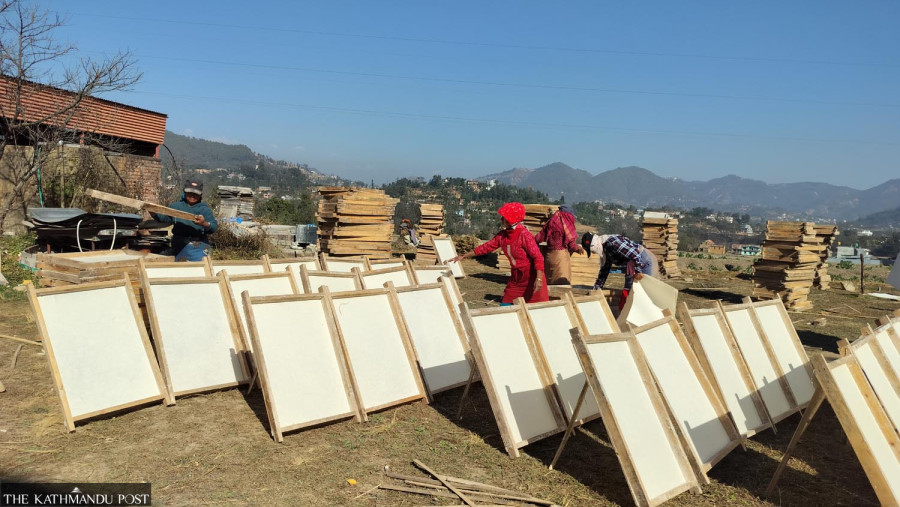Money
Digitisation tears through Nepali handmade paper industry
For centuries, Nepali handmade paper was the trusted choice for legal documents and sacred texts.
Jyoti Shrestha
Hari Kumar Magar, a handmade paper entrepreneur from Banepa Municipality, was forced to close his business due to dwindling demand. His factory has been shut for over a year and a half, reflecting a broader crisis facing the Nepali handmade paper industry.
Traditionally used by government offices for record-keeping, Nepali handmade paper is now on the verge of collapse with the growing wave of digitisation. Several small paper plants in Kavrepalanchok, once thriving with investments worth millions of rupees, have shut down.
Originally from Sindhuli, Magar founded Kanchan Nepali Paper Factory 14 years ago, aiming to build a successful business. However, with demand plummeting, it became difficult to cover production costs, including taxes, rent, and salaries.
“Even after the pandemic, when other businesses started recovering, the handmade paper industry couldn’t bounce back. So, in the end, I had no choice but to shut down,” he said. Magar, who invested Rs2.5 million in his factory, incurred losses of Rs1.5 million.
Purushottam Painju, owner of Friendship Paper Industry in Khopasi, Panauti, has been in the business for two decades. While his enterprise was initially successful, it now faces the same struggles.
“Dealers in Kathmandu say foreign demand has dropped, and orders are down,” Painju said. His factory’s production has fallen from 600 kori (one kori equals 20 sheets) to 500, with 200 kori remaining unsold due to lack of demand.
Lokta paper is famed for its durability and resistance to insects and mildew. According to the UN’s Food and Agriculture Organisation (FAO), the government primarily used it for record-keeping.
Since at least the 12th century, handmade paper has been produced in Nepal’s rural hill districts. The most renowned paper traditionally came from around Baglung.
However, by the 1930s, production declined due to paper imports from Tibet. By the 1960s, competition from machine-made Indian paper further weakened the industry, leaving only a few families in Baglung and Parbat with knowledge of traditional production techniques.
The industry revived in the 1970s as tourism increased.
By the end of the decade, new potential markets emerged. UNICEF and the Asian Development Bank (ADB) launched projects to support lokta cutters and papermakers, including by establishing Bhaktapur Craft Printers in the Kathmandu Valley.
In 1985, key industrial developments reshaped Nepal’s handmade paper industry. The introduction of Japanese technologies improved efficiency while maintaining the craft’s labour-intensive aspects.
Japan has an old tradition of making handmade paper from daphne tree bark fibres. When the method was replicated in Nepal, the concept of sustainability came with it, including in the recycling of lokta paper scraps.
The Japan International Cooperation Agency (JICA) collaborated with the Nepal government to train local entrepreneurs in Japanese techniques.
Around the same time, General Paper Industries became Nepal’s first major private handmade paper company, pioneering Japanese techniques.
According to Mahaguthi Craft with Conscience, a Fair Trade Organization that markets and exports Nepali crafts, handmade paper is made from the bark of Daphne cannabina and Daphne papyracea (lokta), found at altitudes of 2,000–2,700 metres. Producers source lokta from several hill districts including Dolakha.
Harvested every two to three years, the bark is cleaned, boiled, beaten into pulp, and dried in wooden frames under the sun to create sheets.
Tibetan monks have historically used this paper for manuscripts and sacred texts. However, digitisation has drastically reduced government orders, significantly impacting the industry.
Additionally, sourcing raw materials from Dolakha is costly due to high processing and labour expenses. As a result, much of the paper produced never reaches the market, pushing the business closer to collapse.
Painju, like other producers, is uncertain about the future. He plans to scale down production in line with market demand, but remains unsure how long he can sustain operations.
While there is no precise data on the number of Nepali paper enterprises in Kavrepalanchok, the Office of Commerce and Industry records show that only three companies are formally registered.
Ganesh Kagaj Udyog, established in 2000, has not renewed its registration, while Ugratara Hadkeshwar Nepali Kagaj Udyog (2004) and Nepal Kagaj Udyog (2006) are no longer in contact with authorities.
“Many enterprises operated without registration, but even the officially registered ones are now on the verge of closure,” said Sitaram Pokharel, chief of the office.
Despite the versatility of Nepali handmade paper, its higher cost compared to regular paper and the rise of digital documentation have shrunk its market.
Data from the Inland Revenue Office in Kavrepalanchok shows that five Nepali paper enterprises are registered, but not all remain active.
According to the Department of Customs, Nepal exported handmade paper worth Rs335.67 million in the first six months of the current fiscal year.
Major export destinations include Australia, China, France, Germany, the UAE, the UK, the US, and Japan. The paper is used for greeting cards, stationery sets, notebooks, gift-wrapping paper, bags, envelopes, and photo frames.
While Nepali handmade paper remains an important cultural heritage, its future is uncertain as digital alternatives replace traditional documentation methods.




 16.12°C Kathmandu
16.12°C Kathmandu













